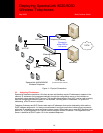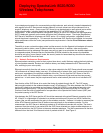
Deploying SpectraLink 8020/8030
Wireless Telephones
May 2009 Best Practices Guide
o When handset 2 is using AP B it receives packets from SVP 2
o When handset 2 is using AP C it receives packets from SVP 2
o When handset 2 is using AP D it receives packets from SVP 1
Handset 3 registers with SVP Server 2
o Handset 3 always sends its packets to SVP 2
− SVP 1 forwards handset 3 audio packets to the call server or PBX
− The call server or PBX sends audio packets from the telephone this handset is in call
with to SVP 2
− SVP 2 sends packets to the SVP managing handset 3’s AP
o When handset 3 is using AP A it receives packets from SVP 1
o When handset 3 is using AP D it receives packets from SVP 1
o When handset 3 is using AP E is receives packets from SVP 1
o When handset 3 is using AP F it receives packets from SVP 2
4.1.3.1 Scenario One
Scenario One assumes that the handset has registered to SVP Server 1, associated to Access Point A,
and managed by SVP Server 1 (Figure 6)
Handset communicates only to SVP Server 1 in this case
SVP Server 1
call server
or PBX
AP A
SpectraLink
handset
SVP Server 2
LAN
Figure 6 - Scenario One
4.1.3.2 Scenario Two
Scenario Two assumes that handset has roamed to Access Point B and is managed by SVP Server 2
(Figure 7)
Packets to handset (from call server or PBX) are first sent through its Home SVP Server (Server
1), then forwarded to SVP Server 2, and then transmitted by AP B to the handset
On the return trip the handset communicates back through AP B to its “Home” SVP Server
(Server 1) and back to the call server or PBX
21
©2009 Polycom, Inc. All rights reserved.
Polycom and the Polycom logo are registered trademarks of Polycom, Inc. All other trademarks are the property of Polycom, Inc. or their respective companies.


















